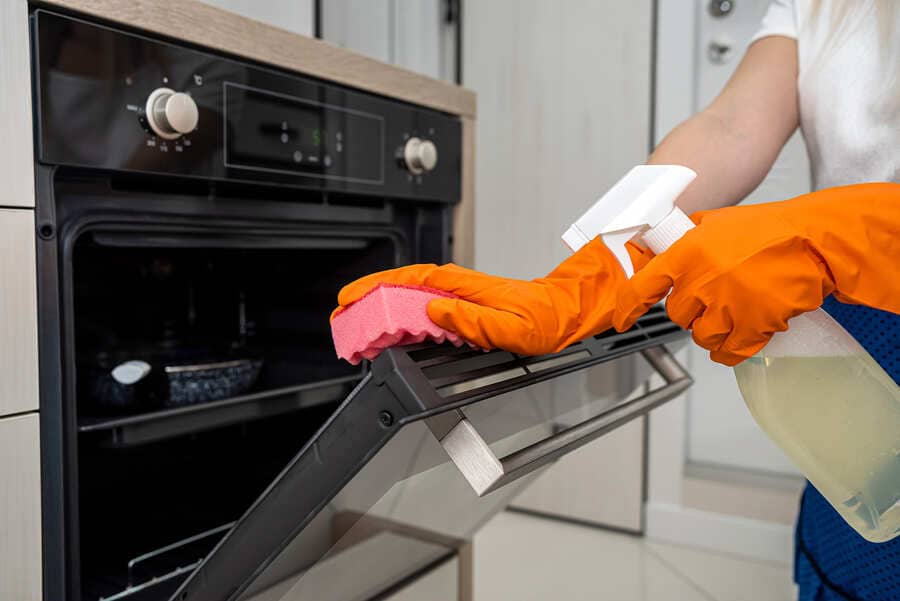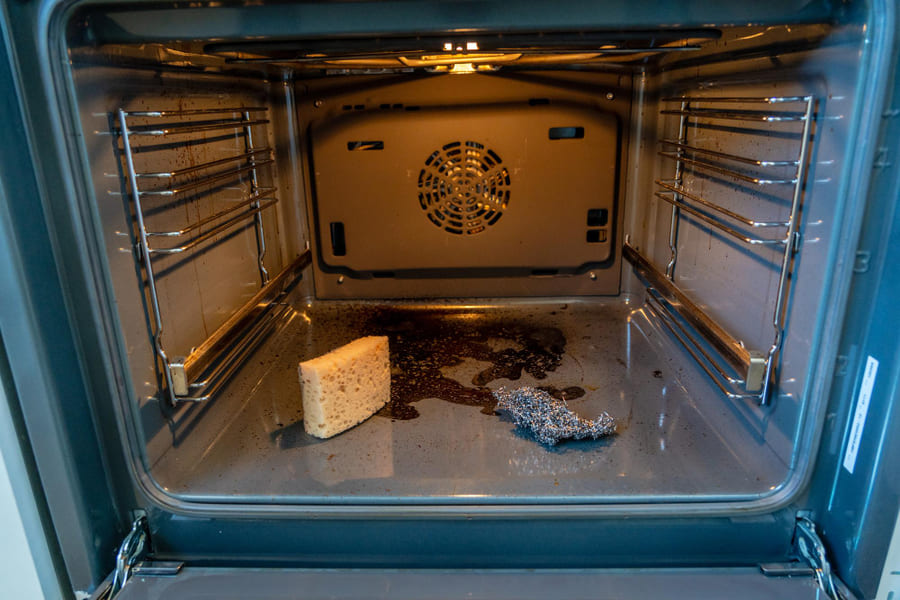It is certainly a dubious impression to the point of saying oven cleaning is as bad as cleaning a toilet cleaning a fridge un-clogging a shower drain (ex., messy, smells funny, and likely left till the baked on food has become its own biome).
If you’ve been delaying the task or you also have a rarely, if ever, used bottle of oven cleaner restfully sitting in the back of your cabinet, it would be time to burn those excuses and open up a life-changing and myth-debunking hack that will make oven cleaning among the easiest jobs you’ll ever have in your house.
I found this technique essentially after the one freaky week making lasagna and cookies and throwing all my big spills and crumbs to the bottom of the crusty oven. I didn’t want to spray chemicals into my melted food, so happened to try this method, and with results so awesome I can’t go back, Let me show you this magical oven-cleaning hack. It’s called ‘Steam Cleaning’.
The Oven Cleaning Game-Changer: The Power of Steam

Steam cleaning your oven might sound fancy or like something only high-tech appliances do but really can be done using a bowl, water, a small amount of vinegar, and the oven you already have.
This hack simply uses steam to do the work for you instead of spraying your oven with chemicals or spending hours in your hot box with your head inside and a scrub brush in hand.
The science? Steam loosens grime, lifts grease, and softens burnt-on food so you can wipe it off before it breaks a sweat. And, because it’s only water and vinegar, you won’t need to worry about a hazy mystery residue or extreme, overpowering smells.
Step-by-Step: How to Steam Clean Your Oven Like a Pro

You don’t need fancy tools or self-cleaning ovens! Just follow these steps:
What You’ll Need:
- 1 heat-resistant glass or ceramic baking dish (like a Pyrex bowl)
- 1 cup water
- 2-3 tablespoons white vinegar
- (Optional: a few drops of lemon juice if you want a fresh scent)
- 1 clean damp cloth or sponge
- Baking soda (for stubborn spots)
Instructions:
- Take out the racks and remove loose food pieces and crumbs. The more area for steam to cover, the better.
- Now take a bowl that can withstand heat and add one cup of water and 2-3 tablespoons of vinegar. A glass or ceramic bowl works best.
- Now put the bowl in the center of the oven, turn the oven to 250 degree F (approx 120 deg C), and close the door to warm it up to steam the surfaces – this will take about 30-45 minutes.
- When the timer goes off, turn off the oven and leave the oven propped open (don’t open it too wide!) for about 10-15 minutes or until you can reach into the oven without burning yourself.
- Wipe the oven down with a damp rag or wet sponge, the most part of the grease will easily wipe off.
Bonus Tip: Add citrus for added cleaning power. If your oven has a funky smell from old food or a certain grease buildup, throw some lemon or orange wedges in with the water before steaming. The citrus will help dissolve residue and make your kitchen smell wonderful.
Why Does It Work?
Here’s why this method is so effective: High heat + moisture = Loose gunk.
When water converts into steam vapor, the expansion leaves behind a penetrating pressure that can lift sticky, hard-to-clean messes. Steam cleaning relies on heating water above boiling point and using high heat + moisture to clean.
The vinegar cuts grease. And guess what? It sanitizes! Steam can disinfect removed bacteria and odors by reaching temperatures hot enough that it ceases to exist, i.e., your oven is not only clean now, but also food-safe.
Why Ditch Traditional Oven Cleaners?

The reality is that most commercial oven cleaner products are loaded with heavy-duty chemicals, sodium hydroxide, butoxydiglycol, and lye, and those are irritating materials that certainly will irritate your skin, eyes, and lungs as you clean. Sure, they work, but is it worth it?
Problems with traditional chemical cleaners:
- Strong fumes
- Risk of skin burns
- Possibility of contaminating food
- Dangerous for children and pets
- Unsafe for the environment
Conversely, steam cleaning is drama free AND it does the job. Steam cleaning is safe, natural, and effective.
Steam vs. Traditional Cleaning: The Side-by-Side Breakdown
If you’re still unsure whether steam cleaning is worth making the shift, let’s get down to business. Conventional ways of cleaning an oven have been around forever and just because these cleaning techniques are tried and true does not mean they are the best options. This is a side-by-side comparison of both techniques for ease of comparison; particularly to see how steam cleans against the classic methods, and why more and more home cooks are opting to switch.
| Feature | Steam Cleaning | Traditional Cleaning |
| Chemicals | None (just water & vinegar) | (often) contain harsh chemicals |
| Time | ~1 hour (mostly passive) | 1 – 2 hours (active scrubbing) |
| Safety | Pet/kid safe, no toxic fumes | Hazardous if inhaled/touched |
| Cost | Practically free | $5–$15 per bottle of cleaner |
| Surface Damage | Gentle | Can scratch or corrode interior |
Conclusion
This steam cleaning hack is not only fun, it’s a way of life. If you are hosting a dinner party, or just want to cook a frozen pizza without setting the smoke alarm off, it’s always easier (and a lot tastier) if your oven is clean. Just try this new oven-cleaning hack once. It only takes one time for this amazing hack to be your door opener, and never be afraid of your oven again. You can also share it with your friends and family.

Numrah Fareed is a freelance writer and home organization enthusiast with a passion for practical, eco-friendly living. When not typing away at her desk, she’s experimenting with DIY cleaning hacks and helping readers simplify their routines one tip at a time.
